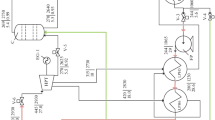Résumé
Les échanges de chaleur entre un réacteur nucléaire et le propulsif et, par conséquent, les performances de la fusée correspondante pourraient être augmentés en opacifiant celui-ci et utilisant ainsi l’énergie émise sous forme de rayonnement par les parois portées à haute température. On montre qu’il est essentiel de tenir compte dans ces échanges radiatifs de la répartition spectrale de l’énergie et des coefficients d’absorption. On évalue numériquement sur un exemple concret le gain possible pour un autropropulseur après avoir choisi les paramètres de façon optimale. Le propulsif utilisé comprend des particules de carbone en suspension dans de l’ammoniac, on montre que l’énergie totale transmise par rayonnement Σ W (θ c , N, r) à une particule qui dépend de la température de celle-ci θ c , de la concentration N, et du rayon r est toujours très loin du maximum correspondant au corps noir. L’intégration numérique (les équations du problème montre que les gains sont obtenus pour une très faible concentration en particules.
Zusammenfassung
Der Wärmeaustausch zwischen einem kernchemischen Reaktor und dem Treibstoff, infolgedessen auch die Leistung der Rakete, könnten erhöht werden, indem letzterer künstlich undurchsichtig gemacht wird und die von den hocherhitzten Behälterwänden ausgestrahlte Energie daher ausgenutzt wird. Man zeigt, daß es bei diesem Wärmeaustausch durch Strahlung wichtig ist, die spektrale Energieverteilung und die Absorptionskoeffizienten zu berücksichtigen. Es wird am Zahlenbeispiel der mögliche Gewinn berechnet, der bei optimaler Parameterwahl für ein Triebwerk möglich ist. Der benutzte Treibstoff enthält Kohlenstaubsuspension in Ammoniak. Es wird gezeigt, daß die durch Strahlung an ein Teilchen übertragene Gesamtenergie Σ W (θ c , N, r), die von der Partikeltemperatur θ c , von seiner Konzentration N und von seinem Radius r abhängt, noch immer weit von dem einem schwarzen Körper entsprechenden Maximum liegt. Die numerische Auswertung der Gleichungen des Problems erweist, daß schon bei sehr schwacher Partikelkonzentration Gewinne erzielbar sind.
Abstract
The exchange of heat between a nuclear reactor and the propellant can be augmented by opacifying the latter and utilizing thus the emitted energy in the form of radiation through the walls at high temperature. It is shown that it is essential to take into account in radiative exchanges the spectral division of the energy and the absorption coefficients. A numerical evaluation of an example shows the possible gain for a propulsion system after having chosen the optimum parameters. The propellant used consists of particles of carbon in suspension in NH3. It is shown that the total energy transmitted by radiation Σ W (θ c , N, r) to a particle which depends on the temperature of the latter θ c , on the concentration N, and on the radius r is always far from the maximum corresponding to the black body. The numerical integration of the equations of the problems shows that gains are obtained for a very small concentration in particles.
Access this chapter
Tax calculation will be finalised at checkout
Purchases are for personal use only
Preview
Unable to display preview. Download preview PDF.
Similar content being viewed by others
Bibliographie
J. J. Barré, Autopropulseurs fissiothermiques. Comptes rendus du IXe Congrès International d’Astronautique, Amsterdam 1958, p. 333. Wien: Springer, 1959.
E. Brun et F. Vasseur, Mécanique des suspensions. G.R.A. Rapport n° 42 /149 (1949).
Tables of Thermal Properties of Gases. National Bureau of Standards (1956).
Tables des propriétés thermodynamiques de l’ammoniac. CEPA RA n° 9 856 (1956).
J. Knudsen et D. Katz, Fluid Dynamics and Heat Transfer New York: McGraw-Hill, 1958.
J. O. Hirschfelder, R. B. Bird et C. F. Curtiss, Molecular Theory of Gases and Liquids. New York: J. Wiley, 1954.
F. Roessler, Propriétés optiques du carbone. Rapport LRSh 4 /52 (1952).
P. Dillon et L.E. Line, Jet Propulsion 26, 1091 (1956).
Author information
Authors and Affiliations
Editor information
Editors and Affiliations
Rights and permissions
Copyright information
© 1960 Springer-Verlag Wien
About this chapter
Cite this chapter
Perrier, P. (1960). Etude d’un échangeur de chaleur par convection et rayonnement pour un autopropulseur fissiothermique. In: Hecht, F. (eds) Xth International Astronautical Congress London 1959 / X. Internationaler Astronautischer Kongress / Xe Congrès International d’Astronautique. Springer, Berlin, Heidelberg. https://doi.org/10.1007/978-3-662-39914-9_52
Download citation
DOI: https://doi.org/10.1007/978-3-662-39914-9_52
Publisher Name: Springer, Berlin, Heidelberg
Print ISBN: 978-3-662-38961-4
Online ISBN: 978-3-662-39914-9
eBook Packages: Springer Book Archive




